Simulation and Experimental Study on Vibration Separation of Residual Film and Soil Based on EDEM
Abstract
1. Introduction
2. Materials and Methods
2.1. Structure of the Vibrating Screen
2.2. Analysis of the Movement of the Screen Body and Materials
2.3. Establishment of a Residual Film-Soil Simulation Model
2.4. Determination of Basic Parameters for EDEM Simulation
2.5. Construction of the Vibrating Screen Model
2.6. Vibration Screening Test Design
2.6.1. Single Factor Experiments
2.6.2. Numerical Simulation Test
3. Results
3.1. Effect of Single Factors on Residual Film-Soil Separation
3.1.1. Screen Aperture Diameter
3.1.2. Vibration Amplitude
3.1.3. Vibration Frequency
3.1.4. Screen Mesh Inclination Angle
3.1.5. Residual Film Area
3.2. Analysis of Response Surface Experiment Results
3.2.1. Box–Behnken Test and Results Analysis
3.2.2. Regression Model and Significance Analysis
3.2.3. Parameter Interaction Effects
3.3. Parameter Optimization and Experimental Verification
3.3.1. Parameter Optimization
3.3.2. Bench Test Validation
4. Discussion
5. Conclusions
Author Contributions
Funding
Data Availability Statement
Conflicts of Interest
References
- Iqbal, B.; Zhao, T.; Yin, W.; Zhao, X.; Xie, Q.; Khan, K.Y.; Zhao, X.; Nazar, M.; Li, G.; Du, D. Impacts of Soil Microplastics on Crops: A Review. Appl. Soil Ecol. 2023, 181, 104680. [Google Scholar] [CrossRef]
- Lakhiar, I.A.; Yan, H.; Zhang, J.; Wang, G.; Deng, S.; Bao, R.; Zhang, C.; Syed, T.N.; Wang, B.; Zhou, R.; et al. Plastic Pollution in Agriculture as a Threat to Food Security, the Ecosystem, and the Environment: An Overview. Agronomy 2024, 14, 548. [Google Scholar] [CrossRef]
- Khan, I.; Tariq, M.; Alabbosh, K.F.; Rehman, A.; Jalal, A.; Khan, A.A.; Farooq, M.; Li, G.; Iqbal, B.; Ahmad, N.; et al. Soil Microplastics: Impacts on Greenhouse Gasses Emissions, Carbon Cycling, Microbial Diversity, and Soil Characteristics. Appl. Soil Ecol. 2024, 197, 105343. [Google Scholar] [CrossRef]
- Chen, Y.F.; Chen, H.; Dai, Y.T.; Xiao, J.L.; Qiu, F.X.; Zhang, T. Honeycomb porous regenerated cellulose aerogel films with enhanced thermal dissipation for agricultural mulch application. Food Bioprod. Process. 2024, 147, 418–427. [Google Scholar] [CrossRef]
- Chen, Y.F.; Dai, Y.T.; Zhu, Y.; Xue, S.L.; Qiu, F.X.; Zhang, T. Transparent cellulose acetate/polyvinylidene difluoride films with heat dissipation for agricultural mulch application. Ind. Crops Prod. 2025, 224, 120302. [Google Scholar] [CrossRef]
- Payanthoth, N.S.; Mut, N.N.N.; Samanta, P.; Li, G.L.; Jung, J.H. A review of biodegradation and formation of biodegradable microplastics in soil and freshwater environments. Appl. Biol. Chem. 2024, 67, 110. [Google Scholar] [CrossRef]
- Cao, J.; Gao, X.; Cheng, Z.; Song, X.; Cai, Y.; Siddique, K.H.M.; Zhao, X.; Li, C. 1The Harm of Residual Plastic Film and Its Accumulation Driving Factors in Northwest China. Environ. Pollut. 2023, 318, 120910. [Google Scholar] [CrossRef]
- Xia, H.; Shen, J.; Riaz, M.; Ran, F.; Cheng, T.; Wang, X.; Dong, Q.; Zu, C.; Liu, B.; Babar, S.; et al. Effects of Agricultural Plastic Films on Crop Growth and Soil Health in Tobacco Fields: A Comparative Study. Appl. Soil Ecol. 2025, 206, 105795. [Google Scholar] [CrossRef]
- Bulati, A.; Zhan, L.; Xu, Z.; Yang, K. Obtaining the Value of Waste Polyethylene Mulch Film Through Pretreatment and Recycling Technology in China. Waste Manag. 2025, 197, 35–49. [Google Scholar] [CrossRef] [PubMed]
- Fang, W.; Wang, X.; Han, D.; Zang, N.; Chen, X.; Ohiemi, I.E. Parameter Optimization and Disturbance Analysis of the Film Picking Device of the Chain-Type Plough Layer Residual Film Recovery Machine Based on DEM-MBD Coupling. Comput. Electron. Agric. 2024, 222, 109041. [Google Scholar] [CrossRef]
- Cao, S.; Xie, J.; Wang, H.; Yang, Y.; Zhang, Y.; Zhou, J.; Wu, S. Design and Operating Parameters Optimization of the Hook-and-Tooth Chain Rail Type Residual Film Picking Device. Agriculture 2022, 12, 1717. [Google Scholar] [CrossRef]
- Gao, Z.; Zhang, X.; Zhang, J.; Wang, Y.; Li, J.; Shen, S.; Dong, W.; Wang, X. Design and Experiment of the Belt-Tooth Residual Film Recovery Machine. Agriculture 2025, 15, 1422. [Google Scholar] [CrossRef]
- Jiang, D.; Yan, L.; Chen, X.; Mo, Y.; Yang, J. Design and Experiment of Nail Tooth Picking Up Device for Strip Type Residual Film Recycling and Baling Machine. Int. J. Agric. Biol. Eng. 2023, 16, 85–96. [Google Scholar] [CrossRef]
- Zhang, Z.; Li, J.; Wang, X.; Zhao, Y.; Xue, S.; Su, Z.; Liang, J. Design and Test of 1SMB-3600A Type Fragmented Mulch Film Collector for Sowing Layer Soil. Soil Tillage Res. 2023, 225, 105555. [Google Scholar] [CrossRef]
- Hu, B.; Serranti, S.; Fraunholcz, N.; Di Maio, F.; Bonifazi, G. Recycling-Oriented Characterization of Polyolefin Packaging Waste. Waste Manag. 2013, 33, 574–584. [Google Scholar] [CrossRef]
- Meneses Quelal, W.O.; Velazquez-Marti, B.; Ferrer Gisbert, A. Separation of Virgin Plastic Polymers and Post-Consumer Mixed Plastic Waste by Sinking-Flotation Technique. Environ. Sci. Pollut. Res. 2022, 29, 1364–1374. [Google Scholar] [CrossRef]
- Lyskawinski, W.; Baranski, M.; Jedryczka, C.; Mikolajewicz, J.; Regulski, R.; Rybarczyk, D.; Sedziak, D. Analysis of Triboelectrostatic Separation Process of Mixed Poly(ethylene terephthalate) and High-Density Polyethylene. Energies 2022, 15, 19. [Google Scholar] [CrossRef]
- Rodrigues, B.M.; Saron, C. Electrostatic Separation of Polymer Waste by Tribocharging System Based on Friction With PVC. Int. J. Environ. Sci. Technol. 2022, 19, 1293–1300. [Google Scholar] [CrossRef]
- Chen, X.; Xi, F.; Geng, Y.; Fujita, T. The Potential Environmental Gains From Recycling Waste Plastics: Simulation of Transferring Recycling and Recovery Technologies to Shenyang, China. Waste Manag. 2011, 31, 168–179. [Google Scholar] [CrossRef]
- Malcolm Richard, G.; Mario, M.; Javier, T.; Susana, T. Optimization of the Recovery of Plastics for Recycling by Density Media Separation Cyclones. Resour. Conserv. Recycl. 2011, 55, 472–482. [Google Scholar] [CrossRef]
- Yang, X.; Zhao, H. Optimum Design of Movement Parameters for Soft Plastic Vibration Sorting Machine’s Screen. In Proceedings of the International Conference on Manufacturing Science and Technology (ICMST 2011), Singapore, 16–18 September 2011; pp. 2875–2879. [Google Scholar]
- Zhu, C.; Chen, B.; Li, J.; Liu, Y.; Yang, L.; Wang, W.; Zhang, H. Design and Testing of the Peanut Pod Cleaning Device. Processes 2023, 11, 106. [Google Scholar] [CrossRef]
- Yang, M.; Zhang, Y.; Zhang, C.; Gu, F.; Yu, Z.; Hu, Z. Design and Experiment of Fan-sieve Combined Peanut Film-Seedling Separating Device Based on Shredding and Separating. Trans. Chin. Soc. Agric. Mach. 2020, 51, 112–121. [Google Scholar]
- Gu, F.; Yang, M.; Hu, Z.; Zhang, Y.; Zhang, C.; Wang, S. Experiment and Optimization of High-Efficiency Mechanical Separation of Peanut Seedlings and Residual Film Based on Suspension Velocity. Trans. Asabe 2021, 64, 1381–1389. [Google Scholar] [CrossRef]
- Xie, J.; Li, Y.; Liu, Y.; Zhang, J.; Du, Y.; Shi, X. Design and Test of Segmented Drum Pneumatically Assisted Potosia brevitarsis Larva Residul Film Mixture Separation Device. Trans. Chin. Soc. Agric. Mach. 2024, 55, 329–341, 428. [Google Scholar]
- Zhou, P.; Chen, X.; Meng, H.; Liang, R.; Zhang, B.; Kan, Z. Design and Experiment of Trommel with Function of Separating Soil from Residual Film Mixture. J. Jilin University. Eng. Technol. Ed. 2023, 53, 2718–2731. [Google Scholar]
- Peng, Q.; Li, C.; Kang, J.; Shi, G. Research and Experiments on a Separation Mechanism for Film-Impurity Aggregates Using a Pneumatic Cylinder Sieve. Trans. Asabe 2020, 63, 1361–1370. [Google Scholar] [CrossRef]
- Peng, Q.; Li, C.; Kang, J.; Shi, G.; Zhang, H. Improved Design and Test on Pneumatic Cylinder Sieve Film Hybrid Separator. Trans. Chin. Soc. Agric. Mach. 2020, 51, 126–135. [Google Scholar]
- Kang, J.; Xie, C.; Peng, Q.; Wang, N.; Wang, X.; Zhang, Y. Analysis of Feed Inlet and Optimal Feeding Amount of Waste Ground Film Impurity Removal Equipment. Appl. Sci. 2023, 13, 9905. [Google Scholar] [CrossRef]
- He, H.; Hu, B.; Pan, F.; Luo, X.; Guo, M.; Xie, Y.; Chen, X. Effects and Experiment on Settlement and Aggregation Behavior of Plastic Film and Cotton Stalk Under the Action of Disturbing Water by the Impeller. Trans. Chin. Soc. Agric. Eng. 2021, 37, 86–95. [Google Scholar]
- Xie, J.; Liu, W.; Cao, S.; Huang, W.; Zhang, J.; Li, Y.; Meng, Q. Design and Test of Countercurrent Hook-Type Residual Film Mixture Cleaning and Separation Device. Trans. Chin. Soc. Agric. Mach. 2025, 56, 397–408. [Google Scholar]
- Zhang, B.; Wang, X.; Liang, R.; Li, J.; Li, Y.; Kan, Z.; Meng, H. Enhancing Resource Utilization: A Novel Method for Effective Separation of Residual Film and Impurities in Cotton Fields. J. Environ. Manag. 2024, 359, 121065. [Google Scholar] [CrossRef]
- Guo, S.; Kan, Z.; Zhang, R.; Guo, W.; An, H.; Cong, T. Separation Test of Electrostatic Separating Device for Machine-Harvested Seed Cotton and Plastic Film Residue. Trans. CSAE 2011, 27, 6–10. [Google Scholar]
- Guo, W.; Kan, Z.; Zhang, R.; Guo, S.; An, H.; Cong, T. Analysis of Material Character Based on Mesh Roller-Type Cotton and Film Remnant Separator. Trans. CSAE 2011, 27, 1–5. [Google Scholar]
- Li, Y.; Zhao, C.; Yan, C.; Mao, L.; Liu, Q.; Li, Z.; He, W. Effects of Agricultural Plastic Film Residues on Transportation and Distribution of Water and Nitrate in Soil. Chemosphere 2020, 242, 125131. [Google Scholar] [CrossRef] [PubMed]
- Zhang, Z.; Zhang, Q.; Xie, S.; Mao, W.; Wang, T.; Wu, H.; Li, X.; Yang, X. Study on Coupling Vibration Sorting Parameters of Waste Plastic Film and Experimental Verification. Environ. Technol. Innov. 2023, 31, 103188. [Google Scholar] [CrossRef]
- Liang, Z.W.; Xu, L.Z.; De Baerdemaeker, J.; Li, Y.M.; Saeys, W. Optimisation of a multi-duct cleaning device for rice combine harvesters utilising CFD and experiments. Biosyst. Eng. 2020, 190, 25–40. [Google Scholar] [CrossRef]
- Xu, L.Z.; Li, Y.; Chai, X.Y.; Wang, G.M.; Liang, Z.W.; Li, Y.M.; Li, B.J. Numerical simulation of gas-solid two-phase flow to predict the cleaning performance of rice combine harvesters. Biosyst. Eng. 2020, 190, 11–24. [Google Scholar] [CrossRef]
- Zhang, Z.; Chen, J.; Li, Y.; Guan, Z.; Liao, C.; Qiao, X. Design and Experiment on the Air-Blowing and Vibrating Supply Seed Tray for Precision Seeders. Int. J. Agric. Biol. Eng. 2022, 15, 115–121. [Google Scholar] [CrossRef]
- Ferellec, J.F.; McDowell, G.R. A method to model realistic particle shape and inertia in DEM. Granul. Matter 2010, 12, 459–467. [Google Scholar] [CrossRef]
- Yang, Q.Z.; Shi, L.; Shi, A.P.; He, M.S.; Zhao, X.Q.; Zhang, L.; Addy, M. Determination of key soil characteristic parameters using angle of repose and direct shear stress test. Int. J. Agric. Biol. Eng. 2023, 16, 143–150. [Google Scholar] [CrossRef]
- Mei, F.; Li, B.; Xu, Z.; Li, X.; Zhu, X. Discrete Element Modeling of Straw Bale: An Innovative Approach to Simulate the Compression Mechanics of Fiber-Based Materials. Comput. Electron. Agric. 2025, 231, 110002. [Google Scholar] [CrossRef]
- Yan, D.; Yu, J.; Wang, Y.; Zhou, L.; Sun, K.; Tian, Y. A Review of the Application of Discrete Element Method in Agricultural Engineering: A Case Study of Soybean. Processes 2022, 10, 1305. [Google Scholar] [CrossRef]
- Kang, J.; Xie, C.; Wang, X.; Chen, Y.; Wang, C.; Peng, Q. Design and Test of Screen Hole Clearing Device for Trommel Sieve Type Membrane Miscellaneous Wind Separator. Trans. Chin. Soc. Agric. Mach. 2022, 53, 91–98. [Google Scholar]
- GB/T 50145-2007; Engineering Classification Standards for Soil. Institute, NHR: Nanjing, China, 2007; p. 38.
- JB/T 4042-2008; Vibrating Screen. Test Methods. Anshan Heavy Duty Mining Machinery Co.: Liaoning, China, 2018.
- GB/T 12620-2008; Long Round Holes, Long Square Holes and Round Hole Sieve Plates. Hunan Ujiang Machinery Screening Co.: Yiyang City, China, 2008; p. 16.
- Kang, J.; Zhang, H.; Zhang, G.; Du, H.; Peng, Q.; Song, Y. Aerodynamic Characteristics of Residual Film Materials and Test of Membrane Separation Device. J. Chin. Agric. Mech. 2020, 41, 167–172. [Google Scholar] [CrossRef]
- Long, H.; Huang, C.; Li, D. Dynamic analysis of beam structure of linear vibrating screen. Aip Adv. 2024, 14, 015101. [Google Scholar] [CrossRef]
- Guo, W.; He, X.; Wang, L.; Zhao, P.; Hu, C.; Hou, S.; Wang, X. Development of a comb tooth loosening and pneumatic stripping plough layer residual film recovery machine. Trans. Chin. Soc. Agric. Eng. 2020, 36, 1–10. [Google Scholar]
- Li, Y.; Zhao, P.; Mo, L.; Ren, T.; Zhang, M. Numerical simulation of particle screening efficiency of large multi-layer vibrating screen based on discrete element method. Proc. Inst. Mech. Eng. Part E-J. Process Mech. Eng. 2022, 236, 565–574. [Google Scholar] [CrossRef]
- Yang, H.; Ma, X. Research on the screening mechanisms of composite vibrating screens based on discrete elements. PLoS ONE 2023, 18, 0293205. [Google Scholar] [CrossRef]
- Yang, H.; Ma, X. Discrete element simulation study on the screening effect of composite vibrating screen for coal particles. Int. J. Coal Prep. Util. 2025, 45, 1–19. [Google Scholar] [CrossRef]
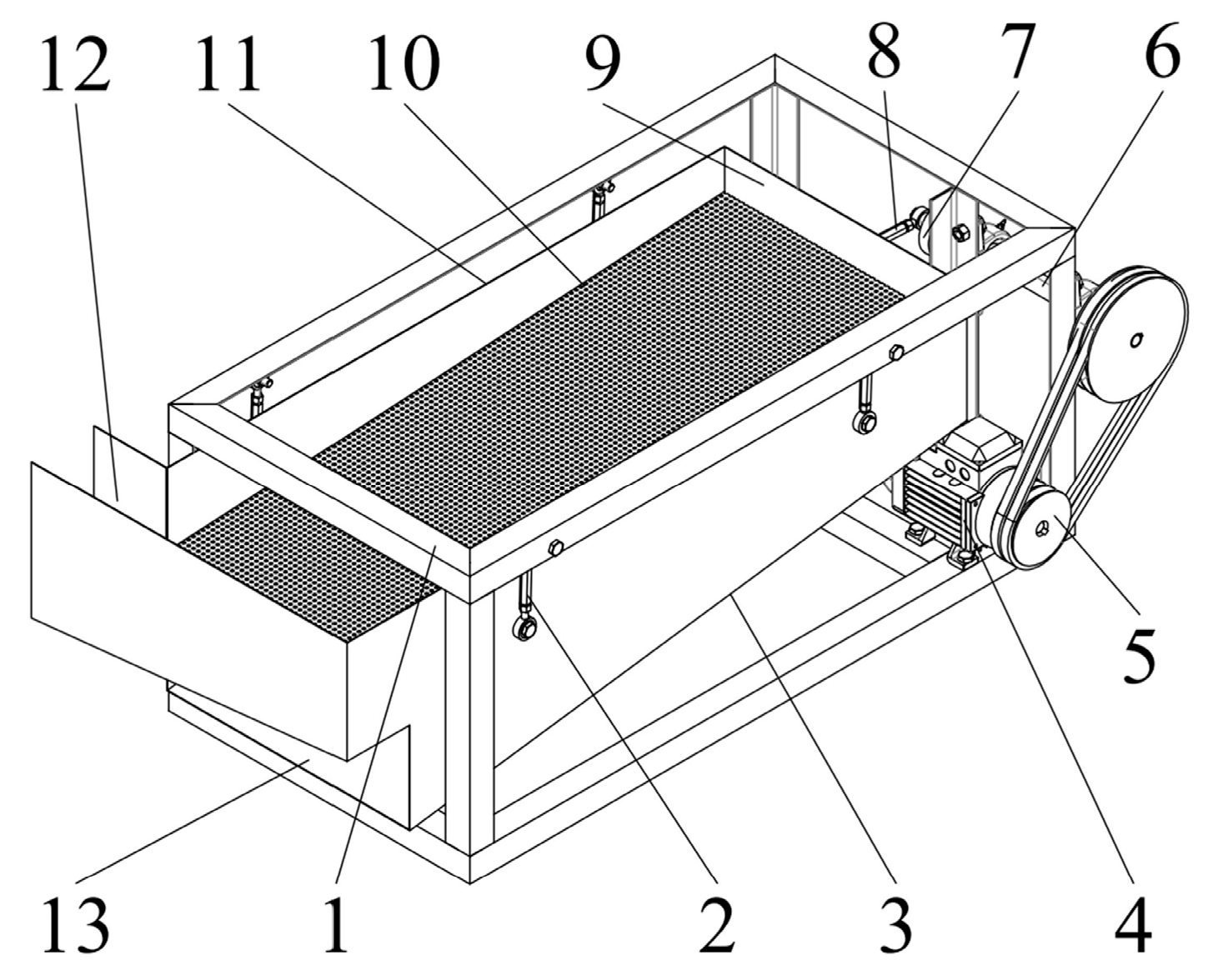

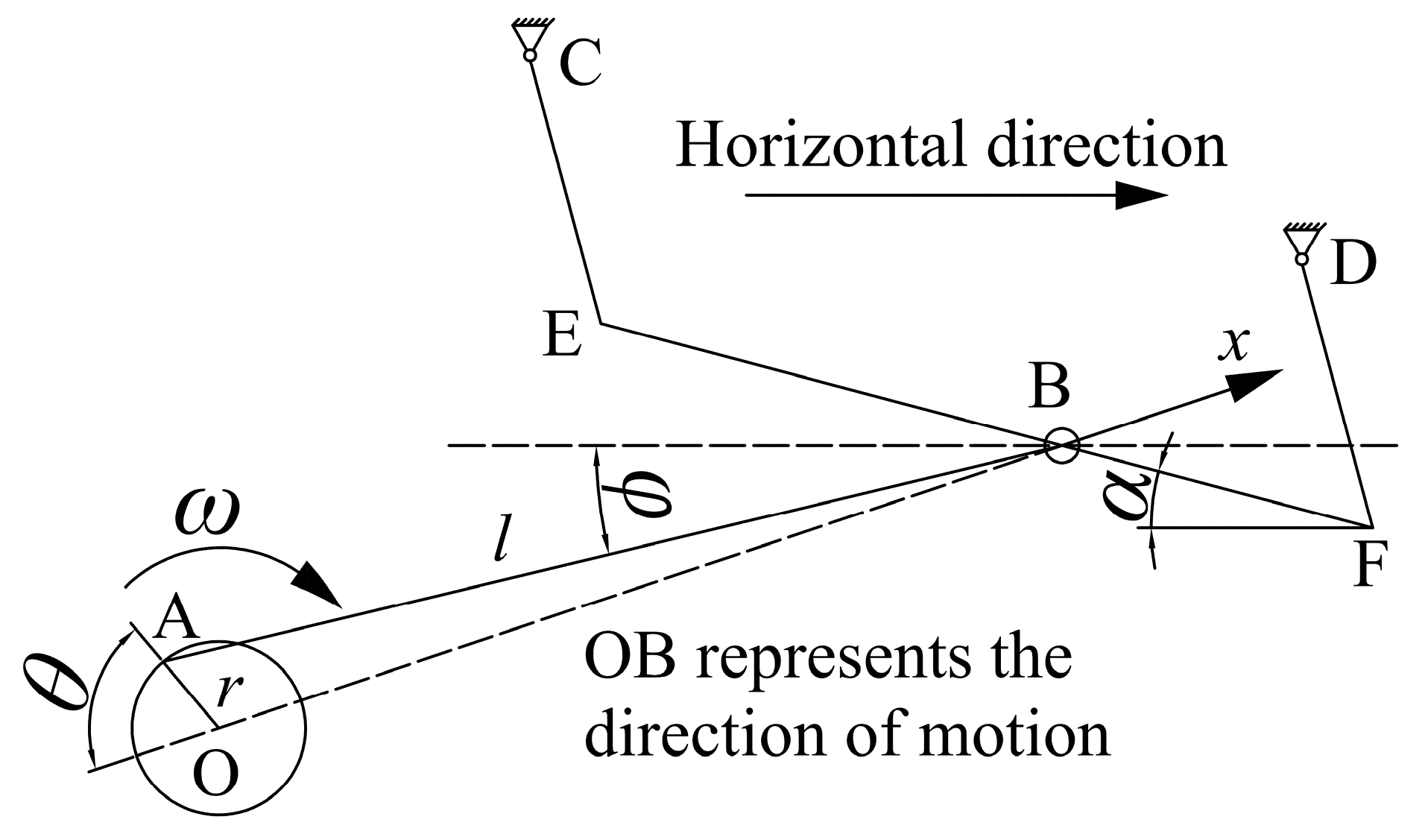




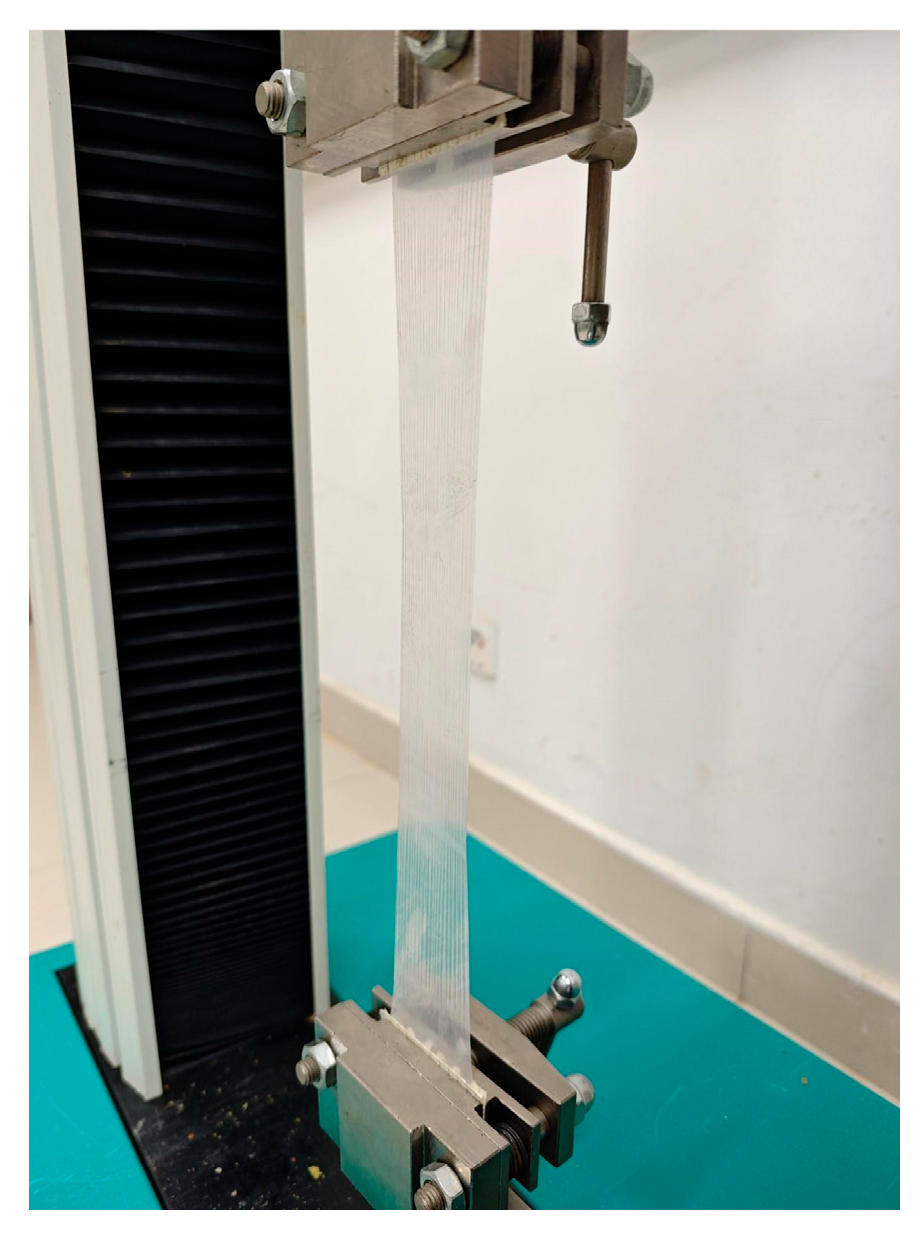


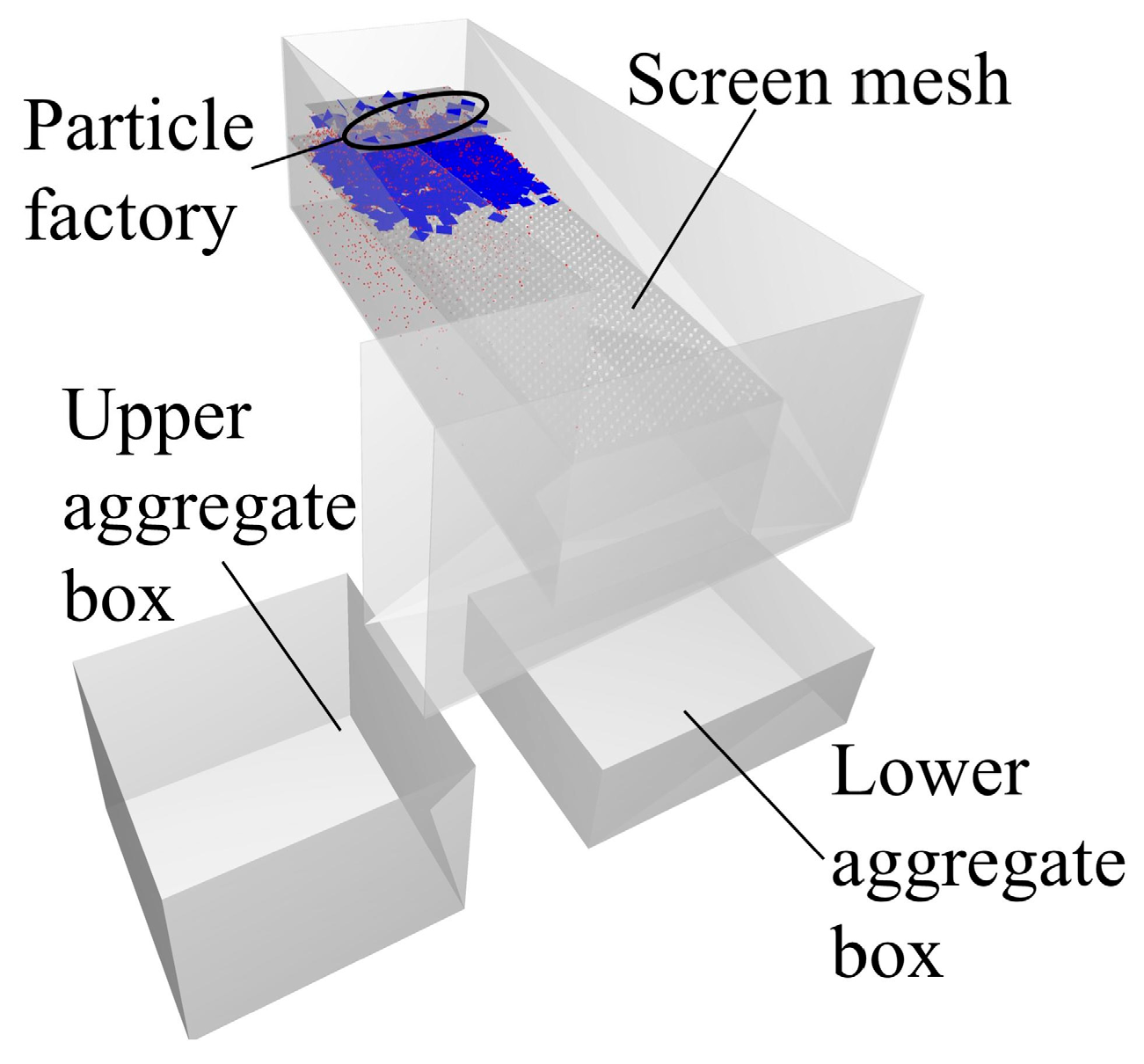

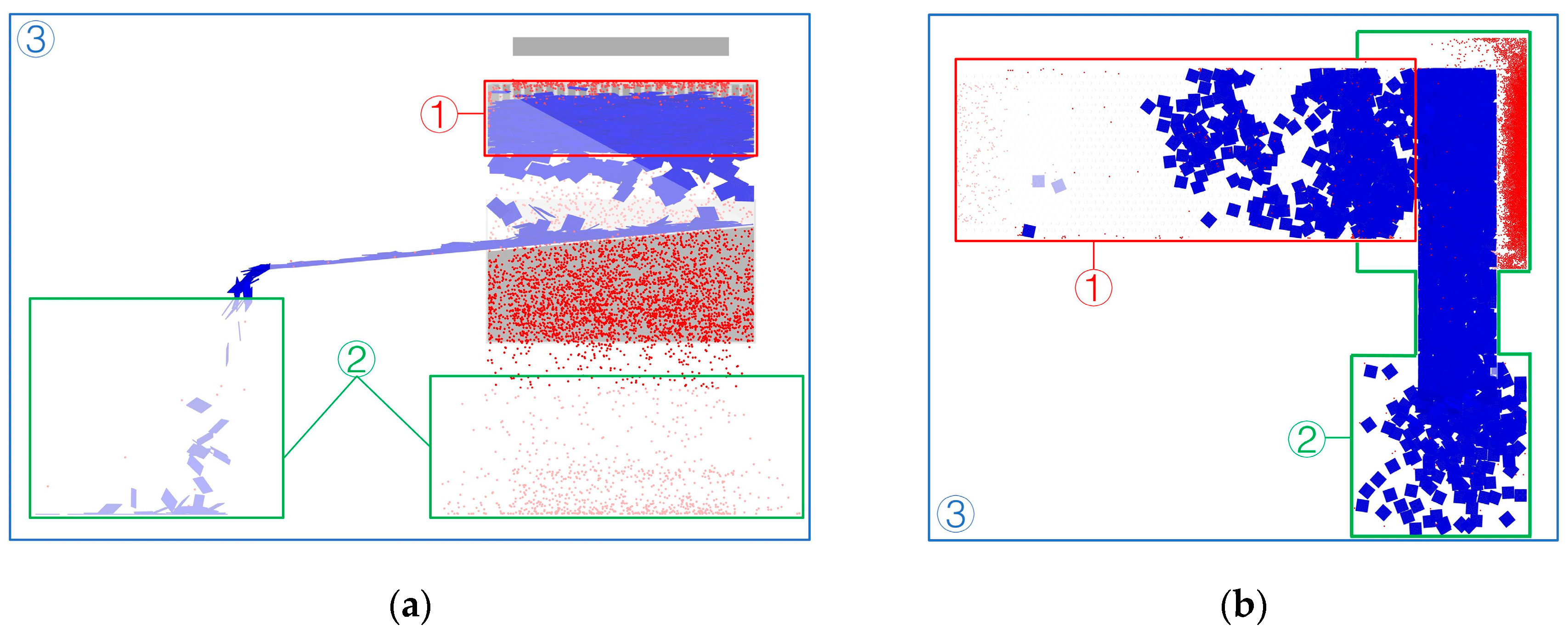



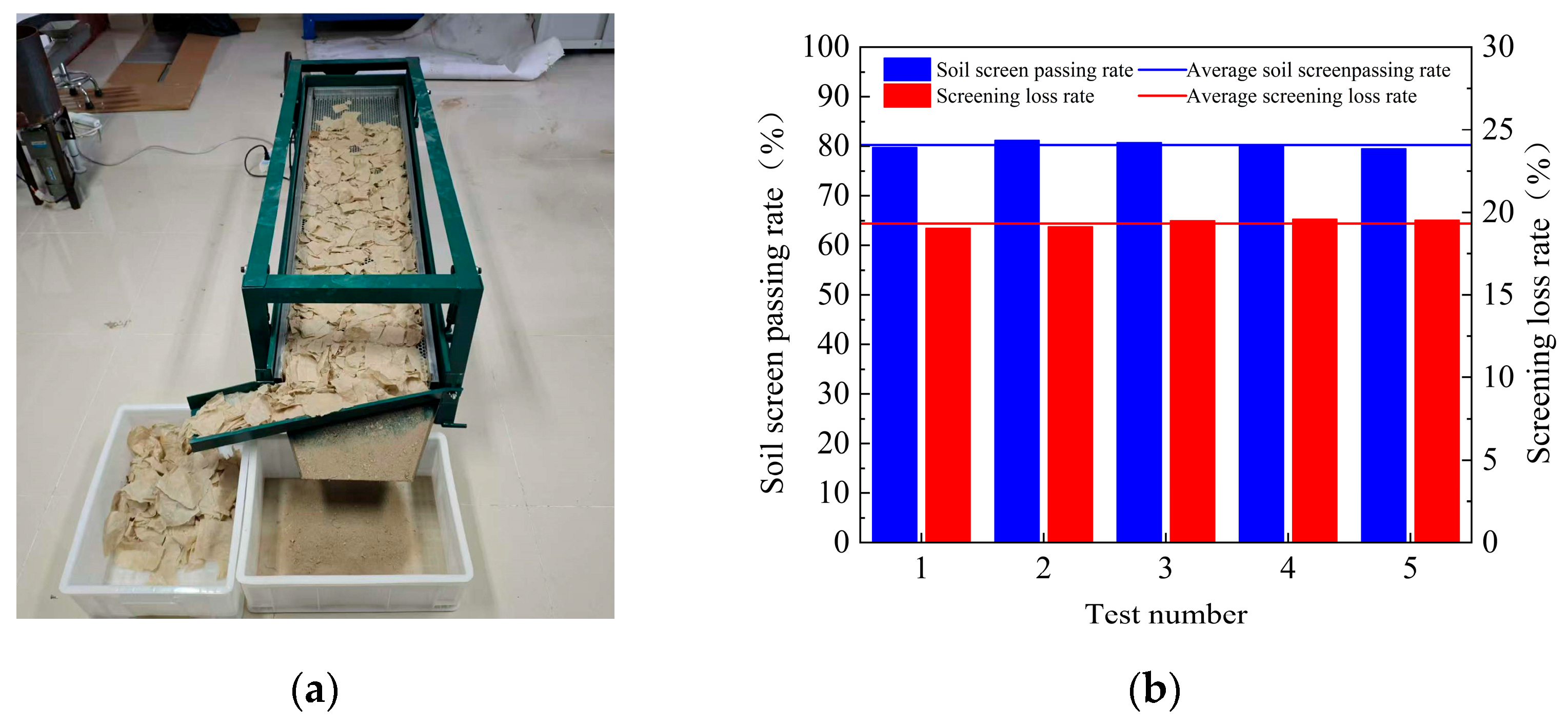
| Type of Force | x Axis Component | y Axis Component |
|---|---|---|
| 0 | ||
| (opposed to the direction of motion) | ||
| Physical Quantity | Actual Value | Simulation Value | Error (%) |
|---|---|---|---|
| Suspension velocity (m·s−1) | 1.98 | 1.88 | 5 |
| Measured Object | 1 | 2 | 3 | 4 | 5 | Average |
|---|---|---|---|---|---|---|
| Residual film | 0.39 | 0.40 | 0.37 | 0.38 | 0.41 | 0.39 |
| Material | Density (kg·m−3) | Shear Modulus (Pa) | Poisson’s Ratio |
|---|---|---|---|
| Residual film | 960 | 8.9 × 106 | 0.39 |
| Soil | 1850 | 5.1 × 106 | 0.29 |
| Stainless steel | 7850 | 2.7 × 1010 | 0.25 |
| Material-Material | Collision Recovery Coefficient | Static Friction Coefficient | Rolling Friction Coefficient |
|---|---|---|---|
| Residual film-residual film | 0.5 | 0.5 | 0.4 |
| Residual film-soil | 0.5 | 0.55 | 0.4 |
| Residual film-stainless steel | 0.5 | 0.42 | 0.37 |
| Soil-soil | 0.52 | 0.74 | 0.22 |
| Soil-stainless steel | 0.4 | 0.45 | 0.30 |
| Number | Factor | |||
|---|---|---|---|---|
| Screen Aperture Diameter A (mm) | Vibration Amplitude B (mm) | Vibration Frequency C (Hz) | Screen Mesh Inclination Angle D (°) | |
| −1 | 5 | 20 | 3 | 3 |
| 0 | 7 | 25 | 4 | 4 |
| 1 | 9 | 30 | 5 | 5 |
| Number | Factor | Evaluation Indicators | ||||
|---|---|---|---|---|---|---|
| A | B | C | D | Soil Screen Passing Rate (%) | Screening Loss Rate (%) | |
| 1 | −1 | −1 | 0 | 0 | 67.70 | 38.30 |
| 2 | 1 | −1 | 0 | 0 | 61.22 | 46.78 |
| 3 | −1 | 1 | 0 | 0 | 52.40 | 59.60 |
| 4 | 1 | 1 | 0 | 0 | 57.58 | 52.42 |
| 5 | 0 | 0 | −1 | −1 | 58.54 | 44.96 |
| 6 | 0 | 0 | 1 | −1 | 59.46 | 46.54 |
| 7 | 0 | 0 | −1 | 1 | 68.14 | 37.36 |
| 8 | 0 | 0 | 1 | 1 | 47.31 | 60.9 |
| 9 | −1 | 0 | 0 | −1 | 73.36 | 28.64 |
| 10 | 1 | 0 | 0 | −1 | 71.30 | 30.70 |
| 11 | −1 | 0 | 0 | 1 | 70.34 | 33.66 |
| 12 | 1 | 0 | 0 | 1 | 70.58 | 33.42 |
| 13 | 0 | −1 | −1 | 0 | 45.14 | 53.86 |
| 14 | 0 | 1 | −1 | 0 | 58.98 | 59.52 |
| 15 | 0 | −1 | 1 | 0 | 57.72 | 61.28 |
| 16 | 0 | 1 | 1 | 0 | 26.58 | 80.42 |
| 17 | −1 | 0 | −1 | 0 | 70.86 | 33.14 |
| 18 | 1 | 0 | −1 | 0 | 64.98 | 43.02 |
| 19 | −1 | 0 | 1 | 0 | 55.54 | 54.46 |
| 20 | 1 | 0 | 1 | 0 | 58.84 | 51.16 |
| 21 | 0 | −1 | 0 | −1 | 55.78 | 49.22 |
| 22 | 0 | 1 | 0 | −1 | 58.20 | 48.08 |
| 23 | 0 | −1 | 0 | 1 | 64.66 | 39.84 |
| 24 | 0 | 1 | 0 | 1 | 46.46 | 66.04 |
| 25 | 0 | 0 | 0 | 0 | 82.04 | 18.96 |
| 26 | 0 | 0 | 0 | 0 | 81.38 | 20.62 |
| 27 | 0 | 0 | 0 | 0 | 81.23 | 19.77 |
| 28 | 0 | 0 | 0 | 0 | 82.12 | 18.88 |
| 29 | 0 | 0 | 0 | 0 | 82.05 | 18.95 |
| Evaluation Indicators | Source | Sum of Squares | df | Mean Square | F-Value | p-Value |
|---|---|---|---|---|---|---|
| Y1 | Model | 4696.55 | 14 | 335.47 | 1405.12 | <0.0001 ** |
| A | 2.71 | 1 | 2.71 | 11.34 | 0.0046 | |
| B | 225.51 | 1 | 225.51 | 944.54 | <0.0001 ** | |
| C | 312.02 | 1 | 312.02 | 1306.9 | <0.0001 ** | |
| D | 6.98 | 1 | 6.98 | 29.22 | <0.0001 ** | |
| AB | 33.99 | 1 | 33.99 | 142.36 | <0.0001 ** | |
| AC | 21.07 | 1 | 21.07 | 88.24 | <0.0001 ** | |
| AD | 1.32 | 1 | 1.32 | 5.54 | 0.0337 | |
| BC | 505.8 | 1 | 505.8 | 2118.56 | <0.0001 ** | |
| BD | 106.3 | 1 | 106.3 | 445.22 | <0.0001 ** | |
| CD | 118.27 | 1 | 118.27 | 495.36 | <0.0001 ** | |
| A2 | 69.82 | 1 | 69.82 | 292.43 | <0.0001 ** | |
| B2 | 2235.81 | 1 | 2235.81 | 9364.75 | <0.0001 ** | |
| C2 | 1682.82 | 1 | 1682.82 | 7048.56 | <0.0001 ** | |
| D2 | 327.17 | 1 | 327.17 | 1370.35 | <0.0001 ** | |
| Residual | 3.34 | 14 | 0.2387 | |||
| Lack of Fit | 2.63 | 10 | 0.2625 | 1.46 | 0.3805 | |
| Pure Error | 0.7173 | 4 | 0.1793 | |||
| Cor Total | 4699.89 | 28 | R2 = 0.9993 | |||
| Evaluation Indicators | Source | Sum of Squares | df | Mean Square | F-Value | p-Value |
|---|---|---|---|---|---|---|
| Y2 | Model | 7097.68 | 14 | 506.98 | 591.8 | <0.0001 ** |
| A | 7.84 | 1 | 7.84 | 9.15 | 0.0091 | |
| B | 491.52 | 1 | 491.52 | 573.75 | <0.0001 ** | |
| C | 572.7 | 1 | 572.7 | 668.52 | <0.0001 ** | |
| D | 44.39 | 1 | 44.39 | 51.82 | <0.0001 ** | |
| AB | 61.31 | 1 | 61.31 | 71.57 | <0.0001 ** | |
| AC | 43.43 | 1 | 43.43 | 50.69 | <0.0001 ** | |
| AD | 1.32 | 1 | 1.32 | 1.54 | 0.2345 | |
| BC | 45.43 | 1 | 45.43 | 53.03 | <0.0001 ** | |
| BD | 186.87 | 1 | 186.87 | 218.13 | <0.0001 ** | |
| CD | 120.56 | 1 | 120.56 | 140.73 | <0.0001 ** | |
| A2 | 188.41 | 1 | 188.41 | 219.93 | <0.0001 ** | |
| B2 | 3782.13 | 1 | 3782.13 | 4414.9 | <0.0001 ** | |
| C2 | 2740.46 | 1 | 2740.46 | 3198.96 | <0.0001 ** | |
| D2 | 331.33 | 1 | 331.33 | 386.76 | <0.0001 ** | |
| Residual | 11.99 | 14 | 0.8567 | |||
| Lack of Fit | 15.65 | 20 | 0.7826 | 0.9843 | 0.5656 | |
| Pure Error | 3.98 | 5 | 0.795 | |||
| Cor Total | 7109.68 | 28 | R2 = 0.9983 | |||
Disclaimer/Publisher’s Note: The statements, opinions and data contained in all publications are solely those of the individual author(s) and contributor(s) and not of MDPI and/or the editor(s). MDPI and/or the editor(s) disclaim responsibility for any injury to people or property resulting from any ideas, methods, instructions or products referred to in the content. |
© 2025 by the authors. Licensee MDPI, Basel, Switzerland. This article is an open access article distributed under the terms and conditions of the Creative Commons Attribution (CC BY) license (https://creativecommons.org/licenses/by/4.0/).
Share and Cite
Wang, X.; Li, Y.; Bai, J. Simulation and Experimental Study on Vibration Separation of Residual Film and Soil Based on EDEM. Agriculture 2025, 15, 1987. https://doi.org/10.3390/agriculture15181987
Wang X, Li Y, Bai J. Simulation and Experimental Study on Vibration Separation of Residual Film and Soil Based on EDEM. Agriculture. 2025; 15(18):1987. https://doi.org/10.3390/agriculture15181987
Chicago/Turabian StyleWang, Xinzhong, Yapeng Li, and Jing Bai. 2025. "Simulation and Experimental Study on Vibration Separation of Residual Film and Soil Based on EDEM" Agriculture 15, no. 18: 1987. https://doi.org/10.3390/agriculture15181987
APA StyleWang, X., Li, Y., & Bai, J. (2025). Simulation and Experimental Study on Vibration Separation of Residual Film and Soil Based on EDEM. Agriculture, 15(18), 1987. https://doi.org/10.3390/agriculture15181987





